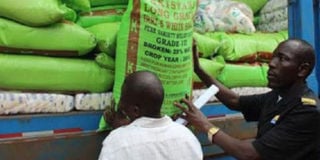Cross-border fraud punches holes in URA tax collection

A Uganda Revenue Authority enforcement officer inspects a consignment of rice and salt. PHOTO/file
What you need to know:
URA is implementing advanced technologies and stricter measures to reduce cross-border trade fraud and boost revenue collection, despite challenges at various customs stations.
Officials from Uganda Revenue Authority (URA) on Wednesday announced the implementation of various measures to combat cross-border fraud to prevent revenue loss.
Mr Robert Kalumba, the URA public and corporate affairs manager, was speaking to Daily Monitor in response to the findings of the 2023 special value-for-money audit report by Mr John Muwanga, the Auditor General.
Mr Kalumba said: “The audit identified several areas of improvement that when effectively addressed, would boost revenue collections.”
The gaps include mis-declarations, concealment of the country of origin, seizures, smuggling, undervaluation, insufficient oversight of authorised economic operators (AEOs), and weaknesses within the verification process.
Mr Kalumba said URA has installed four types of scanners across the country’s 45 border posts, including fixed, mobile, passenger baggage, and handheld scanners.
He said URA has also heightened monthly review of valuation on imports, end of transaction alerts management, slapping of maximum penalties on repeat offenders, and sanctioning corrupt URA staff.
The audit report said despite URA reducing their revenue shortfall from its Customs collections from Shs495b in the Financial Year 2020/2021 to Shs105b in the Financial Year 2022/2023, the authority had failed to curb cross-border trade fraud.
URA collected 98.8 percent of its Shs9.4t Customs revenue in FY 2022/2023. In the FY 2021/2022, the authority registered a surplus of Shs293b after surpassing its Shs8.4t target.
In the next financial year, the government tasked URA to collect Shs31t revenue, up from the current Shs29t.
The report said an analysis of the Customs tax revenue and costs of collection showed that in the 2020/2021 to 2022/2023 period, taking 2020/2021 as an example, for every Shs1b spent on collection of taxes, the Customs department collected Shs76b.
The report noted the trend shows decreasing revenue collection over time. For example, in FY 2021/2022, URA recorded the lowest revenue collected of Shs60b per Shs1b spent in Customs expenses.
Mr Kalumba noted that advanced technologies have minimised corruption by reducing person-to-person engagement and increasing real-time transactions between traders. He also said the installation of non-intrusive inspection (NII) scanners recovered Shs220 billion in the current financial year.
URA was in the 2021/2022 and 2022/2023 financial years prompted to procure and install 39 NII scanners worth Shs47.9b in the 39 border posts to detect trade fraud.
The installation followed an open criticism by President Museveni on September 15, 2021, during celebrations to mark 30 years of URA. He castigated URA for failing to curb corruption and cross-border trade fraud.
He noted that despite having the capacity, URA has failed to curb breaches, resulting in the tax-to-GDP ratio remaining stagnant at 13 percent for the past 20 years.
“You have got a lorry of 40 tonnes, how do you know what is inside? Modern technology simplifies work, but my people here have been avoiding technology for reasons best known to them,” he said.
Mr Abel Kagumire, the commissioner of Customs, then said six X-ray machines had been installed at six border points of Busia, Malaba, Mutukula, Mirama Hills and Elegu.
The authority spent an additional $3.17 million (about Shs11.8 billion) on the supply, delivery, commissioning, training, support, and maintenance of the NII equipment.
Mr Muwanga also listed consistently efficient cross-border stations in the three financial years under review as Malaba one-stop border post, Madi-Opei customs station, Lia customs station, Vurra customs station, Tanzania-Dar es Salaam, Port of Mombasa, Entebbe CAPT, Entebbe Cargo and Courier Centre, Kampala CBC, Post parcels, Port Bell, customs warehouse, central bus terminal and DHL, Masaka Customs station, Mbarara, and Mpondwe one-stop border post.
Others included Jinja and Iganga Customs Station, Lwakhakha Customs Station, Oraba Customs Station, Busia one stop border post (OSBP), Padea Customs Station, Elegu OSBP, Mbale Customs Station, Amudat and Suam river, Goli OSBP and Karuma Customs station, Ishasha River Customs Station,Katuna, Rwanda and Kamwezi, Cyanika and Bunanagana, Mirama Hills OSBP, Mutukula and Bugango, which he said were found to be consistently inefficient over the three-year period reviewed.
“The audit team, through field inspections of various border posts and a system walk-through at the Compliance and Business Analysis division (CBA), observed that all cargo entering the country is scanned at the border posts,” reads part of the report.
More efforts needed
Despite a decrease in revenue lost due to cross-border trade fraud, experts and economists urge URA to double its efforts to combat the issue, which forces the government to resort to borrowing.
The 2018 Global Financial Integrity (GFI) scoping study on Illicit Financial Flows reported a loss of $6.6 billion (about Shs24.9 trillion) through trade mis-invoicing between 2006 and 2015.
Mr Aloysious Kittengo, the programme coordinator-in-charge of Financing for Development at Seatini, said URA must strengthen international cooperation on tax matters, formalise the informal sector as well as strengthen the technical capacity of tax administration to improve their audit capacity.
“Most informal businesses tend to operate outside the formal regulatory frameworks, making tax information inaccessible. Informality also challenges effective tax revenue administration, thus deterring the authority from collecting taxes from potential taxpayers hidden in the informal sector or the dark economy,” he said.
Mr Richard Sempala, a lecturer of Economics at Makerere University, said: “URA should work to improve enforcement. Though there is still limited capacity there. Parts of the border, especially Northern Uganda and West Nile, are still very porous. URA can also improve capacity building with regards to understanding of international trade law.”
What is URA doing?
To address undervaluation, Mr Robert Kalumba, the URA public and corporate affairs manager, mentioned that URA has rolled out different initiatives, including engaging and educating both high and medium risk sectors.
“We are also examining high risk cargo before departure from the factory for goods originating from Kenya; rolling out practical sector-focused refresher training for our staff, deployment of NII scanners and other technologies, audit of high-risk sectors; and slapping progressive penalties for repeat offenders,” he said.
Mr Kalumba said for cargo management area, which is prone to trade fraud, URA has enhanced staff redeployment focusing on high and medium-priority bonded warehouses, as well as implemented daily end-to-end manifest accountability and reconciliation of cargo.
“We have also categorised the clients into three bands aimed at facilitating compliant taxpayer category while effecting targeting high risk category; deployed disruptive/unpredictable interventions targeting high risk, low revenue yielding and non-dutiable imports; restricted the partial ex-warehousing of all high-risk goods; and as well separate transit sheds and export processing areas to address the risk of loss of cargo while in the bonds,’’ he said.
Mr John Mwanga, the Auditor General, in his report said his team reviewed the documents of the URA business compendium and field inspections at bonded warehouses and customs stations.
He noted that all incoming cargo into the country undergoes a risk assessment that leads to either physical examination, documentary check, post-clearance audit, or direct release of the goods based on the lane an individual is assigned.




